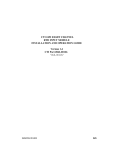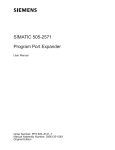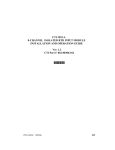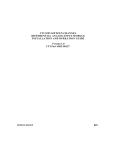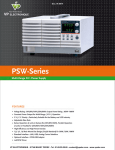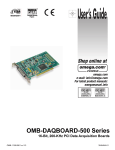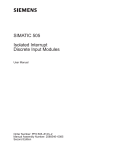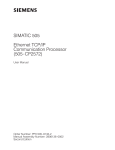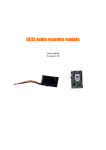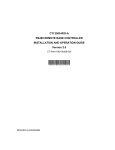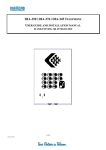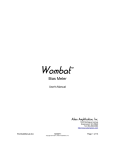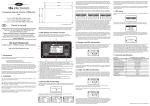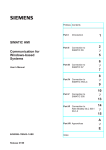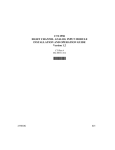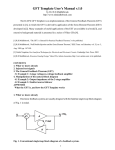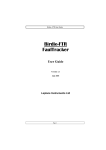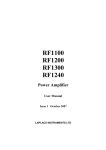Download CTI 2550 EIGHT CHANNEL ISOLATED ANALOG INPUT
Transcript
CTI 2550 EIGHT CHANNEL ISOLATED ANALOG INPUT MODULE INSTALLATION AND OPERATION GUIDE Version 2.0 CTI Part #062-00102 2452IOG 092205 $25 ii CT I 2550 Installation and O peration G uide Copyright © 2005 Control Technology Inc. All rights reserved. This manual is published by Control Technology Inc., 5734 Middlebrook Pike, Knoxville, TN 37921. This manual contains references to brand and product names which are tradenames, trademarks, and/or registered trademarks of Control Technology Inc. Siemens® and SIMATIC® are registered trademarks of Siemens AG. Other references to brand and product names are tradenames, trademarks, and/or registered trademarks of their respective holders. DOCUMENT DISCLAIMER STATEMENT Every effort has been made to ensure the accuracy of this document; however, errors do occasionally occur. CTI provides this document on an "as is" basis and assumes no responsibility for direct or consequential damages resulting from the use of this document. This document is provided without express or implied warranty of any kind, including but not limited to the warranties of merchantablility or fitness for a particular purpose. This document and the products it references are subject to change without notice. If you have a comment or discover an error, please call us toll-free at 1-800-537-8398. CT I 2550 Installation and O peration G uide iii iv CT I 2550 Installation and O peration G uide PREFACE This Installation and Operation Guide provides installation and operation instructions for the CTI 2550 Eight Channel Isolated Analog Input Module for SIMATIC® 505 programmable controllers. We assume you are familiar with the operation of the SIMATIC® 505 programmable controllers. Refer to the appropriate SIMATIC® user documentation for specific information on the SIMATIC® 505 programmable controllers and I/O modules. This Installation and Operation Guide is organized as follows: Chapter 1 provides a description of the module. Chapter 2 covers installation and wiring. Chapter 3 is a guide to troubleshooting. Figure 1 The Model 2550 8-Channel Isolated Analog Input Module CT I 2550 Installation and O peration G uide v vi CT I 2550 Installation and O peration G uide USAGE CONVENTIONS NOTE: Notes alert the user to special features or procedures. CAUTION: Cautions alert the user to procedures which could damage equipment. WARNING: Warnings alert the user to procedures which could damage equipment and endanger the user. CT I 2550 Installation and O peration G uide vii viii CT I 2550 Installation and O peration G uide TABLE OF CONTENTS PREFACE . . . . . . . . . . . . . . . . . . . . . . . . . . . . . . . . . . . . . . . . . . . . . . . . . . . . . . . . . . . . . . . . . . v USAGE CONVENTIONS . . . . . . . . . . . . . . . . . . . . . . . . . . . . . . . . . . . . . . . . . . . . . . . . . . . . . . . vii TABLE OF FIGURES . . . . . . . . . . . . . . . . . . . . . . . . . . . . . . . . . . . . . . . . . . . . . . . . . . . . . . . . . xi CHAPTER 1. DESCRIPTION . . . . . . . . . . . . . . . . . . . . . . . . . . . . . . . . . . . . . . . . . . . . . . . . . . . 1.1 Front Panel Description . . . . . . . . . . . . . . . . . . . . . . . . . . . . . . . . . . . . . . . . . . . . . . . . 1.1.1 Active LED . . . . . . . . . . . . . . . . . . . . . . . . . . . . . . . . . . . . . . . . . . . . . . . . . 1.1.2 Input Connector for Channels 1-4 . . . . . . . . . . . . . . . . . . . . . . . . . . . . . . . . . 1.1.3 Input Connector for Channels 5-8 . . . . . . . . . . . . . . . . . . . . . . . . . . . . . . . . . 1.2 Asynchronous Operation . . . . . . . . . . . . . . . . . . . . . . . . . . . . . . . . . . . . . . . . . . . . . . . 1.3 Unipolar or Bipolar Mode . . . . . . . . . . . . . . . . . . . . . . . . . . . . . . . . . . . . . . . . . . . . . . 1.4 Voltage or Current Mode . . . . . . . . . . . . . . . . . . . . . . . . . . . . . . . . . . . . . . . . . . . . . . . 1.5 Digital Word Map . . . . . . . . . . . . . . . . . . . . . . . . . . . . . . . . . . . . . . . . . . . . . . . . . . . . 1.6 Analog to Digital Conversion . . . . . . . . . . . . . . . . . . . . . . . . . . . . . . . . . . . . . . . . . . . . 1.6.1 Unipolar Mode Conversion . . . . . . . . . . . . . . . . . . . . . . . . . . . . . . . . . . . . . 1.6.2 Bipolar Mode Conversion . . . . . . . . . . . . . . . . . . . . . . . . . . . . . . . . . . . . . . 1.6.3 Example Conversion . . . . . . . . . . . . . . . . . . . . . . . . . . . . . . . . . . . . . . . . . . 1.7 Effect of Out-of-Range Input Signals . . . . . . . . . . . . . . . . . . . . . . . . . . . . . . . . . . . . . . 1.8 Using the Module with 20% Offset . . . . . . . . . . . . . . . . . . . . . . . . . . . . . . . . . . . . . . . 1.9 Resolution . . . . . . . . . . . . . . . . . . . . . . . . . . . . . . . . . . . . . . . . . . . . . . . . . . . . . . . . . . 1 1 1 2 2 2 2 2 2 3 3 5 6 7 9 9 CHAPTER 2. INSTALLATION . . . . . . . . . . . . . . . . . . . . . . . . . . . . . . . . . . . . . . . . . . . . . . . . 2.1 Planning the Installation . . . . . . . . . . . . . . . . . . . . . . . . . . . . . . . . . . . . . . . . . . . . . . 2.1.1 Calculating the I/O Base Power Budget . . . . . . . . . . . . . . . . . . . . . . . . . . . 2.1.2 Input Signal Wiring . . . . . . . . . . . . . . . . . . . . . . . . . . . . . . . . . . . . . . . . . . 2.2 Unpacking the Module . . . . . . . . . . . . . . . . . . . . . . . . . . . . . . . . . . . . . . . . . . . . . . . . 2.3 Configuring the Module . . . . . . . . . . . . . . . . . . . . . . . . . . . . . . . . . . . . . . . . . . . . . . . 2.3.1 Selecting Voltage or Current Input Mode . . . . . . . . . . . . . . . . . . . . . . . . . . 2.3.2 Selecting Voltage Range . . . . . . . . . . . . . . . . . . . . . . . . . . . . . . . . . . . . . . 2.3.3 Selecting Unipolar or Bipolar Input Mode . . . . . . . . . . . . . . . . . . . . . . . . . 2.3.4 Selecting Digital Filtering . . . . . . . . . . . . . . . . . . . . . . . . . . . . . . . . . . . . . . 2.4 Inserting the Module Into the I/O Base . . . . . . . . . . . . . . . . . . . . . . . . . . . . . . . . . . . . 2.5 Wiring the Input Connectors . . . . . . . . . . . . . . . . . . . . . . . . . . . . . . . . . . . . . . . . . . . 2.5.1 Connecting Voltage Input Wiring . . . . . . . . . . . . . . . . . . . . . . . . . . . . . . . . 2.5.2 Connecting Current Input Wiring . . . . . . . . . . . . . . . . . . . . . . . . . . . . . . . . 2.6 Inserting the Screw Terminal Plug . . . . . . . . . . . . . . . . . . . . . . . . . . . . . . . . . . . . . . . 2.7 Checking Module Operation . . . . . . . . . . . . . . . . . . . . . . . . . . . . . . . . . . . . . . . . . . . 11 11 11 11 12 13 13 14 14 15 16 16 17 17 17 18 CHAPTER 3. TROUBLESHOOTING . . . . . . . . . . . . . . . . . . . . . . . . . . . . . . . . . . . . . . . . . . . . 19 CT I 2550 Installation and O peration G uide ix SPECIFICATIONS . . . . . . . . . . . . . . . . . . . . . . . . . . . . . . . . . . . . . . . . . . . . . . . . . . . . . . . . . . . 21 JUMPER SETTINGS LOG SHEET . . . . . . . . . . . . . . . . . . . . . . . . . . . . . . . . . . . . . . . . . . . . . . 23 USER NOTES . . . . . . . . . . . . . . . . . . . . . . . . . . . . . . . . . . . . . . . . . . . . . . . . . . . . . . . . . . . . . . 25 LIMITED PRODUCT WARRANTY . . . . . . . . . . . . . . . . . . . . . . . . . . . . . . . . . . . . . . . . . . . . . 27 REPAIR POLICY . . . . . . . . . . . . . . . . . . . . . . . . . . . . . . . . . . . . . . . . . . . . . . . . . . . . . . . . . . . . 29 x CT I 2550 Installation and O peration G uide TABLE OF FIGURES Figure 1 The Model 2550 8-Channel Isolated Analog Input Module . . . . . . . . . . . . . . . . . . . . . . Figure 2 2550 Front Panel . . . . . . . . . . . . . . . . . . . . . . . . . . . . . . . . . . . . . . . . . . . . . . . . . . . . . . Figure 3 Word Input to the PLC from the Module (Unipolar) . . . . . . . . . . . . . . . . . . . . . . . . . . . Figure 4 Word Input to the PLC from the Module (Bipolar) . . . . . . . . . . . . . . . . . . . . . . . . . . . . . Figure 5 Maximum Non-Overrange Word Value (Unipolar) . . . . . . . . . . . . . . . . . . . . . . . . . . . . Figure 6 Minimum Non-Underrange Word Value (Unipolar) . . . . . . . . . . . . . . . . . . . . . . . . . . . . Figure 7 Maximum Non-Overrange Word Value (Bipolar) . . . . . . . . . . . . . . . . . . . . . . . . . . . . . . Figure 8 Minimum Non-Underrange Word Value (Bipolar) . . . . . . . . . . . . . . . . . . . . . . . . . . . . . Figure 9 Example of Change in Input Level . . . . . . . . . . . . . . . . . . . . . . . . . . . . . . . . . . . . . . . . . Figure 10 Voltage Input Limits (Unipolar) . . . . . . . . . . . . . . . . . . . . . . . . . . . . . . . . . . . . . . . . . . Figure 11 Voltage Input Limits (Bipolar) . . . . . . . . . . . . . . . . . . . . . . . . . . . . . . . . . . . . . . . . . . . Figure 12 Overrange Word Value (Unipolar) . . . . . . . . . . . . . . . . . . . . . . . . . . . . . . . . . . . . . . . Figure 13 Underrange Word Value (Unipolar) . . . . . . . . . . . . . . . . . . . . . . . . . . . . . . . . . . . . . . Figure 14 Overrange Word Value (Bipolar) . . . . . . . . . . . . . . . . . . . . . . . . . . . . . . . . . . . . . . . . . Figure 15 Underrange Word Value (Bipolar) . . . . . . . . . . . . . . . . . . . . . . . . . . . . . . . . . . . . . . . . Figure 16 Input Resolution . . . . . . . . . . . . . . . . . . . . . . . . . . . . . . . . . . . . . . . . . . . . . . . . . . . . Figure 17 Factory Configuration Jumper Settings . . . . . . . . . . . . . . . . . . . . . . . . . . . . . . . . . . . Figure 18 Configuration Jumper Locations . . . . . . . . . . . . . . . . . . . . . . . . . . . . . . . . . . . . . . . . Figure 19 Screw Terminal Plug Wiring . . . . . . . . . . . . . . . . . . . . . . . . . . . . . . . . . . . . . . . . . . . Figure 20 Input Connector Wiring . . . . . . . . . . . . . . . . . . . . . . . . . . . . . . . . . . . . . . . . . . . . . . . Figure 21 Example I/O Configuration Chart . . . . . . . . . . . . . . . . . . . . . . . . . . . . . . . . . . . . . . . Figure 22 Troubleshooting Matrix . . . . . . . . . . . . . . . . . . . . . . . . . . . . . . . . . . . . . . . . . . . . . . . Figure 23 Jumper Settings Log . . . . . . . . . . . . . . . . . . . . . . . . . . . . . . . . . . . . . . . . . . . . . . . . . CT I 2550 Installation and O peration G uide xi v 1 3 3 4 4 5 6 6 7 7 8 8 8 9 10 14 15 16 17 18 19 23 xii CT I 2550 Installation and O peration G uide CHAPTER 1. DESCRIPTION The Eight Channel Analog Input Module is a member of Control Technology's family of I/O modules compatible with the SIMATIC® 505 programmable controllers. The Model 2550 is designed to translate an analog input signal into an equivalent digital word which is then sent to the programmable controller (PLC). 1.1 Front Panel Description Figure 2 2550 Front Panel 1.1.1 Active LED The active LED will be illuminated when the module is functioning normally. If the Active LED is not lit, refer to Chapter 3 for troubleshooting. CT I 2550 Installation and O peration G uide 1 1.1.2 Input Connector for Channels 1-4 This connector provides wiring terminals for channels 1-4. 1.1.3 Input Connector for Channels 5-8 This connector provides wiring terminals for channels 5-8. 1.2 Asynchronous Operation The module operates asynchronously with respect to the PLC (a scan of the PLC and input sampling of the module do not occur at the same time). Instead, the module will translate all analog inputs in one module update (2 milliseconds maximum) and store the translated words in buffer memory. The PLC retrieves the stored words from the module buffer memory at the start of the I/O scan. 1.3 Unipolar or Bipolar Mode The module may be configured to accept either bipolar or unipolar input signals. Selection of unipolar or bipolar mode is made via two internal jumpers (see Section 2.3.3). 1.4 Voltage or Current Mode Each of the module's eight channels may be configured to receive either voltage or current analog input signals. For unipolar input signals, the range is 0 to 5 VDC, 0 to 10 VDC or 0 to +20 mA. For bipolar input signals, the signal range is -5 to +5 VDC, -10 to +10 VDC or -20 to +20 mA. Selection of voltage or current mode and voltage range are made via internal jumpers (see Sections 2.3.1 and 2.3.2). 1.5 Digital Word Map A unipolar analog input signal is translated into a 12-bit plus sign bit digital word. A bipolar input signal is translated into an 11-bit digital word plus 1-bit for the polarity sign. Since the PLC requires a 16-bit input word, the 12-bit value from the converter is placed into a 16-bit word for transmittal to the PLC. As shown in the following figure, of the four bits not used for the digital word, one is used to show the sign of the word, one is used to note values which are “overrange”, and the remaining bits are not used and are set to zero. 2 CT I 2550 Installation and O peration G uide Figure 3 Word Input to the PLC from the Module (Unipolar) As shown in the following figure, of the four bits not used for the digital word, one is used to show the sign of the word, one is used to note values which are “overrange”, and the remaining bits are not used and are set to zero. Figure 4 Word Input to the PLC from the Module (Bipolar) 1.6 Analog to Digital Conversion 1.6.1 Unipolar Mode Conversion The following equations may be used to calculate the digital word which will result from a particular voltage or current input in the Unipolar Input Mode: CT I 2550 Installation and O peration G uide 3 0 to 5V Input Range Mode, Digital Word (WX) = Input voltage (V) x 32000 ÷ 5 volts Note: Maximum digital word (WX) is +32,761 for voltages > 5.11V 0 to 10V Input Range Mode, Digital Word (WX) = Input voltage (V) x 32000 ÷ 10 volts Note: Maximum digital word (WX) is +32,761 for voltages > 10.23V 0 to 20 mA Input Range Mode, Digital Word (WX) = Input current (mA) x 32000 ÷ 20 mA Note: Maximum digital word (WX) is +32,761 for current > 20.47mA The following figures show the bit conditions for the maximum and minimum non-overrange values in Figure 5 Maximum Non-Overrange Word Value (Unipolar) Figure 6 Minimum Non-Underrange Word Value (Unipolar) unipolar mode: 4 CT I 2550 Installation and O peration G uide 1.6.2 Bipolar Mode Conversion The following equations may be used to calculate the digital word which will result from a particular voltage or current input in the Bipolar Input Mode: -5 to +5V Input Range Mode, Digital Word (WX) = + Input voltage (V) x 32000 ÷ 5 volts Note: Maximum digital word (WX) is +32,753 for voltages > 5.11V Minimum digital word (WX) is -32,767 for voltages <-5.12V -10 to +10V Input Range Mode, Digital Word (WX) = + Input voltage (V) x 32000 ÷ 10 volts Note: Maximum digital word (WX) is +32,753 for voltages > +10.23V Minimum digital word (WX) is -32,767 for voltages < -10.24V -20 to +20 mA Input Range Mode, Digital Word (WX) = + Input current (mA) x 32000 ÷ 20 mA Note: Maximum digital word (WX) is +32,753 for current > +20.46mA Minimum digital word (WX) is -32,767 for current < -20.47mA The following figures show the bit conditions for the maximum and minimum non-overrange values in Figure 7 Maximum Non-Overrange Word Value (Bipolar) bipolar mode: CT I 2550 Installation and O peration G uide 5 Figure 8 Minimum Non-Underrange Word Value (Bipolar) 1.6.3 Example Conversion As an example, the following figure illustrates the effects of a change in input level going from 1.25 to 2.5 mV in the 0 to 5V Unipolar Input Mode. (For the 0 to 10V and 0 to 20mA Unipolar Input Modes, or the Bipolar Modes, refer to the formulas given in Sections 1.6.1 and 1.6.2 to determine the digital Figure 9 Example of Change in Input Level word which results from a particular input.) 6 CT I 2550 Installation and O peration G uide 1.7 Effect of Out-of-Range Input Signals In Unipolar Mode, when the analog signal exceeds the positive limit, the translated digital word will exceed 32000 to a maximum of +32760 (See Figure 5). Above this point the overrange bit will be set giving an overrange reading of +32761 (See Figure 12). Signals falling below the lower limits in 0 to 5V Input Mode or 0 to 10V Input Mode are translated into a digital word equivalent to -1 (See Figure 13). Note that although the digital word may approach zero as the analog input signal approaches the minimum for a given range, the digital word will never actually be 0 (See Figure 6). Thus, in the 0 to 5V Input Mode, input signals below the 0.00125V minimum result in a translated digital word of -1 (all 1's). Similarly, in the 0 to 10V Input Mode, input Figure 10 Voltage Input Limits (Unipolar) signals below the 0.00250V minimum are translated into a digital word equivalent to -1 (all 1's). In Bipolar Mode, when the analog input signal is outside the normal operating range, the translated digital word will exceed 32000 to a maximum of +32753 for positive going signals or -32767 for negative going signals. The following figure shows the effects of excessive voltage on the module. See Figure 11 Voltage Input Limits (Bipolar) Figures 7 and 8 for maximum and minimum bipolar word values. See Figures 14 and 15 for overrange and underrange bipolar word values. CT I 2550 Installation and O peration G uide 7 Figure 12 Overrange Word Value (Unipolar) Figure 13 Underrange Word Value (Unipolar) Figures 12 and 13 show the binary values of overrange and underrange conditions for Unipolar mode. Figure 14 Overrange Word Value (Bipolar) Figures 14 and 15 show the binary values of overrange and underrange conditions for Bipolar mode. 8 CT I 2550 Installation and O peration G uide CT I 2550 Installation and O peration G uide 9 Figure 15 Underrange Word Value (Bipolar) 1.8 Using the Module with 20% Offset Some applications use transducers that provide 1 to 5 volt (4 to 20 mA) input signals instead of 0 to 5 volt (0 to 20 mA) input signals. You can allow for this 20% offset by including some additional instructions in your RLL (Relay Ladder Logic) program. First, subtract 6400 from the input data word (WX). Then, multiply the result by 125 and divide the product by 100. This yields the following equation: (WX -6400) x 125 ÷ 100 = 20% offset data word Consult your PLC programming manual (or program design guide) for information about the RLL instructions used in the conversion. 1.9 Resolution In the Unipolar Input Mode, the module has a resolution of 8 counts out of 32000. That is, the smallest unit into which the module will divide an input is 1 part out of 4000. This relationship can be shown as: 8 counts per step ÷ 32000 counts full scale = 1/4000 In Bipolar Mode, the resolution is 16 counts out of 32000, so that the smallest unit into which the module will divide an input is 1 part out of 2000. This relationship can be shown as: 16 counts per step ÷ 32000 counts full scale = 1/2000 When using the module with 20% offset, module resolution remains at 8 counts out of 32000, but offset resolution becomes 10 counts out of 32000 as a result of the multiplication and division of the incoming data word. 10 CT I 2550 Installation and O peration G uide The chart below shows the corresponding input resolution per step for each of the input configuration Figure 16 Input Resolution modes: CT I 2550 Installation and O peration G uide 11 12 CT I 2550 Installation and O peration G uide CHAPTER 2. INSTALLATION The installation of the Eight Channel Analog Input Module involves the following steps: 1. Planning the installation 2. Configuring the module 3. Inserting the module into the I/O base 4. Wiring and connecting the module input connectors 5. Checking module operation The steps listed above are explained in detail in the following pages. 2.1 Planning the Installation Planning is the first step in the installation of the module. This involves calculating the I/O base power budget and routing the input signal wiring to minimize noise. The following sections discuss these important considerations. 2.1.1 Calculating the I/O Base Power Budget The Model 2550 requires 2.5 watts of +5 V power from the I/O base. Use this value to verify that the base power supply capacity is not exceeded. 2.1.2 Input Signal Wiring Input signal wiring must be shielded twisted-pair cable. The shielding for the cable should always be terminated at the Model 2550. Each isolated input channels contains its own local ground for the shield wire. The input isolation amplifier is designed in this manner by the manufacturer. Standard practices usually require that all shields be tied together and grounded at a single point. In an isolated system this will actually impede the system to reject noise. The correct method for terminating the shields on an isolated channel is to connect them to the channel's local ground Gn (n = 1 to 8 depending on the channel number). This will provide the best performance. There should never be any shield termination at the source end of the signal wire. CT I 2550 Installation and O peration G uide 13 Note the following general considerations when wiring the module: Always use the shortest possible cables Avoid placing low voltage wire parallel to high energy wire (if the two wires must meet, cross them at a right angle) Avoid bending the wire into sharp angles Use wireways for wire routing Be sure to provide a proper earth ground for the cable shield at the signal source Avoid placing wires on any vibrating surface 2.2 Unpacking the Module Open the shipping carton and remove the special anti-static bag which contains the module. CAUTION: HANDLING STATIC SENSITIVE DEVICES The components on the Model 2550 module printed circuit card can be damaged by static electricity discharge. To prevent this damage, the module is shipped in a special anti-static bag. Static control precautions should be followed when removing the module from the bag, when opening the module, and when handling the printed circuit card during configuration. After discharging any static build-up, remove the module from the static bag. Do not discard the static bag. Always use this bag for protection against static damage when the module is not inserted into the I/O backplane. 14 CT I 2550 Installation and O peration G uide 2.3 Configuring the Module The Model 2550 must be configured for voltage or current inputs, voltage range, unipolar/bipolar mode, and digital filtering/no filtering mode before wiring the input connectors and inserting the module into the I/O base. As shipped, all input channels are configured for current inputs, 5V range (see Note below), unipolar mode, and digital filtering enabled (see Figure 17). NOTE: The 5V input signal range configuration is used for both 0 to 5 VDC and 1 to 5 VDC or 4 to 20 mA and 0 to 20 mA input signal ranges. Changing the module input channel configuration involves the following steps: 1. Selecting voltage (V) or current (I) input mode for each channel 2. Selecting 0 to 5V or 0 to 10V voltage range for each channel 3. Selecting unipolar or bipolar input mode for the module 4. Selecting digital filtering or no filtering for the module 5. Logging the configuration jumper settings for future reference Each of these steps is described in the following sections. 2.3.1 Selecting Voltage or Current Input Mode Locate the 8 Voltage/Current Jumpers corresponding to input channels 1 through 8. See Figure 18 for the location of these jumpers. For each input channel, select current mode by placing the jumper in the “I” position or voltage mode by placing the jumper in the “V” position. For each input channel set to current mode, you must set the corresponding Voltage Range Jumper to the 5V position as described in the following section. CT I 2550 Installation and O peration G uide 15 2.3.2 Selecting Voltage Range Locate the Voltage Range Jumpers corresponding to input channels 1 through 8 (see Figure 18). For each input channel operating in current mode, set the corresponding Voltage Range Jumper to 5V. CAUTION: For each input channel configured for current mode, the corresponding Voltage Range Jumper must be set to 5V or damage will result to the module. Figure 17 Factory Configuration Jumper Settings For each input channel operating in voltage mode, set the corresponding Voltage Range Jumper to 5V for 0 to -5 to +5 volt input range or 10V for 0 to -10 to +10 volt input range. 2.3.3 Selecting Unipolar or Bipolar Input Mode Locate the Unipolar/Bipolar Jumpers JP2 and JP5 (see Figure 18). Set both jumpers to UNP for unipolar operation or BIP for bipolar operation. Note that the Unipolar/Bipolar Jumper settings affect all 8 input channels. 16 CT I 2550 Installation and O peration G uide Figure 18 Configuration Jumper Locations 2.3.4 Selecting Digital Filtering Locate the Digital Filtering/No Filtering Jumper JP6 (see Figure 18). To enable digital filtering, set the jumper in the FIL position. Since many analog input signals contain noise, CTI recommends using digital filtering unless maximum response time is required. CT I 2550 Installation and O peration G uide 17 2.4 Inserting the Module Into the I/O Base WARNING: The module must not be inserted into the I/O rack while power is applied. Insert the module into the I/O base by carefully pushing the module into the slot. When the module is fully seated in the slot and backplane connector, tighten the captive screws at the top and bottom to hold the module in place. To remove the module from the I/O base, loosen the captive screws, then remove the module from the I/O base. Be careful not to damage the edge card at the back of the module when inserting or removing the module. 2.5 Wiring the Input Connectors Input signals are accepted through a connector assembly located on the front of the module. The connector assembly consists of a header attached to the printed circuit card and a mating removable screw terminal plug (see Figure 19). Wiring is connected through the screw terminal plug. The screw terminals can accept wire sizes up to single stranded 12 gauge wire. The actual size wire used depends on the external device providing the input signal. Consult the device manufacturer's recommendations for selecting the input wire size. To assign an input to a specific channel, locate the appropriate channel position on the screw terminal plug as shown in the following figure: 18 CT I 2550 Installation and O peration G uide Figure 19 Screw Terminal Plug Wiring CT I 2550 Installation and O peration G uide 19 2.5.1 Connecting Voltage Input Wiring For voltage input circuits, connect the signal wire to the + (positive) screw terminal, and the return wire to the - (negative) screw terminal. The ground terminals labeled G1 through G8 provide a convenient location to terminate the shield. Insert the wires in the appropriate holes at the top of the plug directly above the screws. When the wires are inserted, tighten the screws. Repeat this procedure for the remaining voltage input channels. 2.5.2 Connecting Current Input Wiring For current input circuits, connect the signal wire to the + (positive) screw terminal, and the return wire to the - (negative) screw terminal. The ground terminals labeled G1 through G8 provide a convenient location to terminate the shield. Insert the wires in the appropriate holes at the top of the plug directly above the screws. When the wires are inserted, tighten the screws. Repeat this procedure for the remaining current input channels. 2.6 Inserting the Screw Terminal Plug When all the input signal wires are connected to the screw terminal plug, carefully insert each plug into its mating header connector on the top and bottom of the module. Both the plug and the header are keyed to prevent reverse wiring. When the screw terminal plug is fully inserted into the header, the Figure 20 Input Connector Wiring locking tabs snap over the connector lip to secure the screw terminal plug to the header. 20 CT I 2550 Installation and O peration G uide 2.7 Checking Module Operation First turn on the base supply power. If the module diagnostics detect no problems, the status indicator on the front of the module will light. If the status indicator does not light (or goes out during operation), the module has detected a failure. For information on viewing failed module status, refer to your SIMATIC® VPU or TISOFT user manual. To diagnose and correct a module failure, refer to the next section on troubleshooting. You must also check that the module is configured in the memory of the PLC. This is important because the module will appear to be functioning regardless of whether it is communicating with the PLC. To view the PLC memory configuration chart listing all slots on the base and the inputs or outputs associated with each slot, refer to your SIMATIC® VPU or TISOFT Programming Manual. Figure 21 Example I/O Configuration Chart An example chart is shown in the following figure. In this example, the Model 2550 module is inserted in slot 1 in I/O base 1. Data for channel 1 appears in word location WX1, data for channel 2 appears in word location WX2, etc. For your particular module, look in the chart for the number corresponding to the slot occupied by the module. If word memory locations appear on this line, then the module is registered in the PLC memory and the module is ready for operation. If the line is blank or erroneous, re-check the module to ensure that it is firmly seated in the slots. Generate the PLC memory configuration chart again. If the line is still incorrect, contact your local distributor or CTI at 1-800-537-8398 for further assistance. CT I 2550 Installation and O peration G uide 21 22 CT I 2550 Installation and O peration G uide CHAPTER 3. TROUBLESHOOTING If the module provides improper readings or the status indicator is not on, use the following chart to Figure 22 Troubleshooting Matrix determine the appropriate corrective action. When it is inconvenient to visually check the status indicator, use the VPU or TISoft “Display Failed I/O” or “Show PLC Diagnostics” support functions. Note that if the module power supply (user CAUTION: The module fuse is not user serviceable. If this fuse is blown, the module has a serious component failure and should be returned to CTI for repair. supply) fails, the module will still be logged into the PLC even though it is not operating. In this case, “Display Failed I/O” will not provide the information to accurately diagnose the problem. If after consulting the chart above, you are unable to diagnose or solve the problem, contact your local distributor or CTI at 1-800-537-8398 for further assistance. CT I 2550 Installation and O peration G uide 23 24 CT I 2550 Installation and O peration G uide SPECIFICATIONS Input Channels: 8 isolated input channels Signal Range: Unipolar: 0 to 5 VDC, 0 to 10 VDC, or 0 to 20 mA Bipolar: -5 to +5 VDC, -10 to +10 VDC , or -20 to +20 mA Update Time: 1 mSec no filtering 2 mSec digital filtering enabled Digital Filtering Time Constant: 0.3 Sec DC Input Resistance: Voltage Mode: 1MS Current Mode: 250S Repeatability: .0.05% Accuracy: Voltage Mode: 0.1% of full scale from 0 to 60C Current Mode: 0.2% of full scale from 0 to 60C Resolution: Unipolar: 12 bit plus sign 0-5 VDC range=1.25 mV/step 0-10 VDC range=2.5 mV/step Bipolar: 11 bit plus sign +5 to -5 VDC=2.5 mV/step +10 to -10 VDC range=5 mV/step Common Mode Rejection: >110db @ 60Hz (digital filtering disabled) Normal Mode Rejection: >45db @ 60Hz (digital filtering enabled) Input Protection: Input ESD Protection: 20,000 V Overrange Protection: 100 V Isolation: 1500 VDC channel-to-channel 1500 VDC channel-to-PLC Module Size: Single wide Backplane Power Consumption: 2.5 Watts Operating Temperature: Storage Temperature: Humidity, Relative: Shipping Weight: 0/ to 60/C (32/ to 140/F) -40/ to 85/C (-40/ to 185/F) 5% to 95% (non-condensing) 1.5 lbs (0.68 Kg) Specifications subject to change without notice. CT I 2550 Installation and O peration G uide 25 26 CT I 2550 Installation and O peration G uide JUMPER SETTINGS LOG SHEET Figure 23 Jumper Settings Log Record the configuration jumper settings on this log for future reference. Make additional copies if necessary. CT I 2550 Installation and O peration G uide 27 28 CT I 2550 Installation and O peration G uide USER NOTES CT I 2550 Installation and O peration G uide 29 30 CT I 2550 Installation and O peration G uide LIMITED PRODUCT WARRANTY CTI warrants that this CTI Industrial Product shall be free from defects in material and workmanship for a period of one (1) year after purchase from CTI or from an authorized CTI Industrial Distributor. This CTI Industrial Product will be newly manufactured from new and/or serviceable used parts which are equal to new in the Product. Should this CTI Industrial Product fail to be free from defects in material and workmanship at any time during this one (1) year warranty period, CTI will repair or replace (at its option) parts or Products found to be defective and shipped prepaid by the customer to a designated CTI service location along with proof of purchase date and associated serial number. Repair parts and replacement Product furnished under this warranty will be on an exchange basis and will be either reconditioned or new. All exchanged parts or Products become the property of CTI. Should any Product or part returned to CTI hereunder be found by CTI to be without defect, CTI will return such Product or part to the customer. This warranty does not include repair of damage to a part or the Product resulting from: failure to provide a suitable environment as specified in applicable Product specifications, or damage caused by an accident, disaster, acts of God, neglect, abuse, misuse, transportation, alterations, attachments, accessories, supplies, non-CTI parts, non-CTI repairs or activities, or to any damage whose proximate cause was utilities or utility like services, or faulty installation or maintenance done by someone other than CTI. Control Technology Inc. reserves the right to make changes to the Product in order to improve reliability, function, or design in the pursuit of providing the best possible Product. CTI assumes no responsibility for indirect or consequential damages resulting from the use or application of this equipment. THE WARRANTY SET FORTH ABOVE IN THIS ARTICLE IS THE ONLY WARRANTY CTI GRANTS AND IT IS IN LIEU OF ANY OTHER IMPLIED OR EXPRESSED GUARANTY OR WARRANTY ON CTI PRODUCTS, INCLUDING WITHOUT LIMITATION, ANY WARRANTY OF MERCHANTABILITY OR OF FITNESS FOR A PARTICULAR PURPOSE AND IS IN LIEU OF ALL OBLIGATIONS OR LIABILITY OF CTI FOR DAMAGES IN CONNECTION WITH LOSS, DELIVERY, USE OR PERFORMANCE OF CTI PRODUCTS OR INTERRUPTION OF BUSINESS, LOSS OF USE, REVENUE OR PROFIT. IN NO EVENT WILL CTI BE LIABLE FOR SPECIAL, INCIDENTAL, OR CONSEQUENTIAL DAMAGES. SOME STATES DO NOT ALLOW THE EXCLUSION OR LIMITATION OF INCIDENTAL OR CONSEQUENTIAL DAMAGES FOR CONSUMER PRODUCTS, SO THE ABOVE LIMITATIONS OR EXCLUSIONS MAY NOT APPLY TO YOU. THIS WARRANTY GIVES YOU SPECIFIC LEGAL RIGHTS, AND YOU MAY ALSO HAVE OTHER RIGHTS WHICH MAY VARY FROM STATE TO STATE. CT I 2550 Installation and O peration G uide 31 32 CT I 2550 Installation and O peration G uide REPAIR POLICY In the event that the Product should fail during or after the warranty period, a Return Material Authorization number (RMA) can be requested verbally or in writing from CTI main offices. Whether this equipment is in or out of warranty, a Purchase Order number provided to CTI when requesting the RMA number will aid in expediting the repair process. The RMA number that is issued and your Purchase Order number should be referenced on the returning equipment's shipping documentation. Additionally, if under warranty, proof of purchase date and serial number must accompany the returned equipment. The current repair and/or exchange rates can be obtained by contacting CTI's main office at 1-800-537-8398. When returning any module to CTI, follow proper static control precautions. Keep the module away from polyethylene products, polystyrene products and all other static producing materials. Packing the module in its original conductive bag is the preferred way to control static problems during shipment. Failure to observe static control precautions may void the warranty. For additional information on static control precautions, contact CTI's main office at 1-800-537-8398. CT I 2550 Installation and O peration G uide 33













































